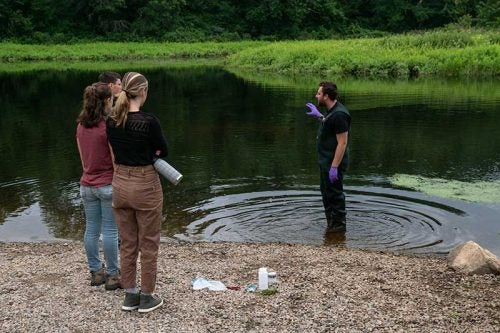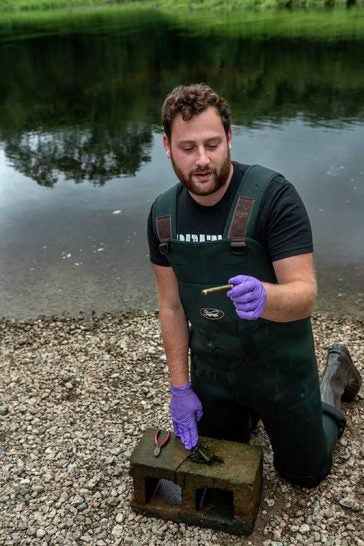
The world of PFAS is not an easy one to traverse, even for those of us who are so-called experts. PFAS is an abbreviation for a family of thousands of compounds called per- and polyfluoroalkyl substances. These compounds share common features including a carbon backbone with many fluorine atoms attached. The litany of abbreviations that exist within the PFAS class of chemicals, from PFOA to the jumbled N-EtFOSAA, still cause me endless confusion and stress. Mix in the growing list of communities affected and the myriad health effects, and I get it — it’s confusing and overwhelming.
That’s why I take great solace in the fact that my research is all about simplicity. At URI, under the guidance of STEEP director Rainer Lohmann, I work on something called passive sampling. Passive, meaning it requires no power source, mechanical process, and little to no maintenance to sample PFAS in a selected body of water.
Passive sampling might not sound all that important, given its humble description and construction, but it is a major upgrade on how we typically measure PFAS in the environment. Prior to passive samplers, if you wanted to know how much PFAS was in your local bay, river, or pond — not to mention air and soil, a scientist would come and take a grab sample (a bottle of water) to measure in the lab. However, this is only a measurement of PFAS at one specific time, location, and set of environmental conditions including temperature, tides, or water flow speed. How will it change with tides, or rain, or the time of year? Taking many water samples across time and space is expensive and requires a significant investment in labor on the end of PFAS scientists.
Instead, we now employ passive samplers that measure PFAS minute by minute, day by day, giving you an average concentration over time. Think of it as a broad overview of your average exposure to PFAS, instead of a specific one-time notice of exposure that leaves you asking more questions.
 Perhaps the greatest thing about passive samplers is their simplicity, which makes handling them easy and efficient. They’re small, allowing for discrete deployment that lessens the chance of an overly enthusiastic environmentalist mistakenly plucking it out of the water as trash. The simplicity of their design and deployment also empowers non-scientist stakeholders to easily deploy, recover, and mail them back to a lab for analysis themselves.
Perhaps the greatest thing about passive samplers is their simplicity, which makes handling them easy and efficient. They’re small, allowing for discrete deployment that lessens the chance of an overly enthusiastic environmentalist mistakenly plucking it out of the water as trash. The simplicity of their design and deployment also empowers non-scientist stakeholders to easily deploy, recover, and mail them back to a lab for analysis themselves.
The widespread application of this technology greatly expands our ability to understand what ecosystems and communities are at risk and to what degree. And while we know a lot about PFAS already, we are only scratching the surface when it comes to the widespread detection of the thousands of chemicals that exist in the PFAS family. General use of these passive samplers can allow a scientist like me to measure PFAS concentrations in an entire river over the course of a month. Better yet, it would take the same amount of labor to deploy and collect the 24 samplers as it would to take a dozen water samples. And the information from the passive samplers is far more comprehensive as well as more useful and informative to communities, scientists, and regulators.
My research has entirely focused on developing and testing this technology here at URI. And I’m delighted to report that it is working. A numerical model gives us scientists the ability to predict the uptake of PFAS by the sampler given very little information about an ecosystem. Does it feature running, or stagnant water? What is the approximate temperature? How long will you leave the sampler out there? That’s it, and we can provide a great deal of information back to those who deploy and recover these little white tube passive samplers.
As my graduate work continues to progress, I’ve worked to deploy these samplers in Rhode Island waters, refine their design, and spread the word that PFAS detection doesn’t always need to be as expensive, complicated, or as intimidating as it has been. While there is much to discuss about PFAS as a public health problem, I’m focusing on the one thing I can do; make it easier for communities to discover the frequency and magnitude of their exposure. After all, knowledge is power and power is crucial when addressing an ever-increasing use of PFAS chemicals that promise intensification of human health problems, environmental degradation, and, ultimately, an inevitable big bill for cleanup.
Matthew Dunn
K.C. Donnelly Externship Award

